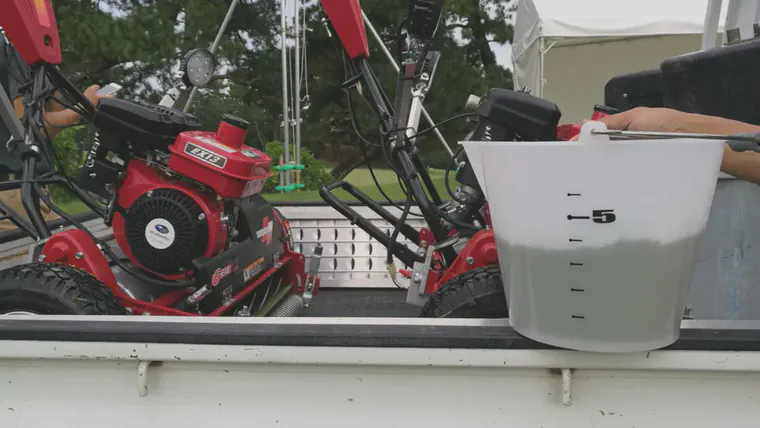Turfgrass GvX, nitrogen harvest, and fertilizer adjustment
Is there a way to estimate how much nitrogen is harvested in clippings? Is there an equation to use to adjust a nitrogen fertilizer rate based on the Turf GvX?1 Yes, there are ways to do both of these. I described them during an ATC Office Hours episode with Bjarni Hannesson and Jason Haines.
These are the equations, or calculations, I described.
Estimating nitrogen harvest in clippings
When you have clipping volume, this is a straightforward estimate.
On average, the dry weight of the clippings will be 6% of the uncompressed fresh weight.2 That is, for every 1,000 cm3 of fresh clippings, you can expect them to have a mass of about 60 g.

Then, you can estimate the N percentage of the clippings. It is reasonable to use a value of 4% for N content of the clippings.3 You can adjust this if you have some data from your own site. The 60 g of dry clippings that we have estimated from the 1,000 cm3 of fresh clippings will be 2.4 g of N.
I have recommended for a long time to make this calculation in reverse, starting with a N application rate of say 1 g/m2. That much N could produce about
Adjusting nitrogen rate using GvX
In our conversation, Jason made the good point that if the grass is growing faster than his desired GvX, he won’t apply N. If the grass is growing slower than his desired GvX, he will apply N. That’s a simple approach and there’s a lot to be said for making adjustments in that way.
I have the idea that if the standard N rate is appropriate—and by that I mean low enough—then one can apply that rate adjusted by the ratio of desired GvX to actual GvX. Chris Tritabaugh shared that equation in one of the comments, and I discussed it, and I wanted to explain that a bit more here as well.
Let
I’m suggesting that
That adjustment can be expressed in this equation, adjusting the standard amount of N to get the actual amount of N to apply in this application—call
When the desired GvX is higher than actual, then the nitrogen rate gets adjusted up. When the grass is growing more than the desired GvX, then the nitrogen rate gets adjusted down.
The Turf GvX is “growth versus expected” and has previously refererred to as a speedometer (speedo) or growth ratio. ↩︎
For data about this conversion, which works for creeping bentgrass, see the data in the supplemental information published along with Zhou et al., 2021. My research on this gets a similar value for creeping bentgrass and for Tifeagle bermudagrass. For Zoysia matrella I’ve calculated a conversion factor of about 10%. ↩︎
It’s reasonable to assume 4% for most species on putting greens. I have been checking leaf nutrient content for multiple species and have found the value for bentgrass to be above 4% in samples collected from 2019 through 2023. Using 4% may be a slight underestimation for creeping bentgrass. I’d use 4% for bermudagrass, 4 or 5% for Poa annua, 3% for seashore paspalum, 2% for zoysia, and I don’t know for fine fescue—I’d guess about 3% at the time of writing. ↩︎
I have suggested in the past to use trailing 14 day average. This value is a compromise. A trailing 30 day average seems too far into the past for me. I’m not sure I want my fertilizer application tomorrow to be influenced by how the grass was growing 23 days ago. But I want to get a little bit of history in there too. If I only mowed four times in the past week, and the temperatures fluctuated a lot, is the trailing 7 day average stable enough for this purpose? There’s some flexibility with how one can do this. At the time of writing, I’m going with 14 days as my recommendation. ↩︎